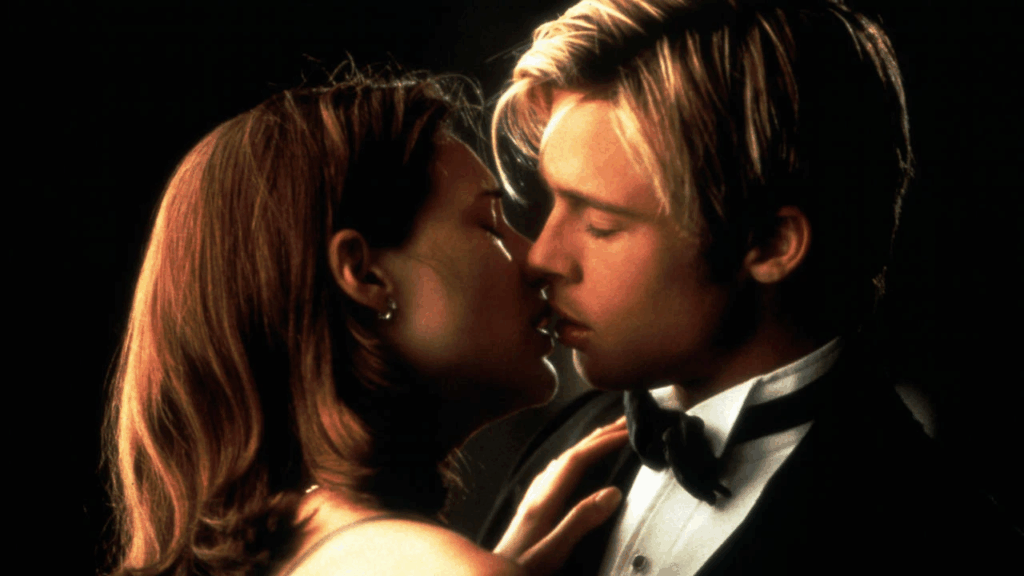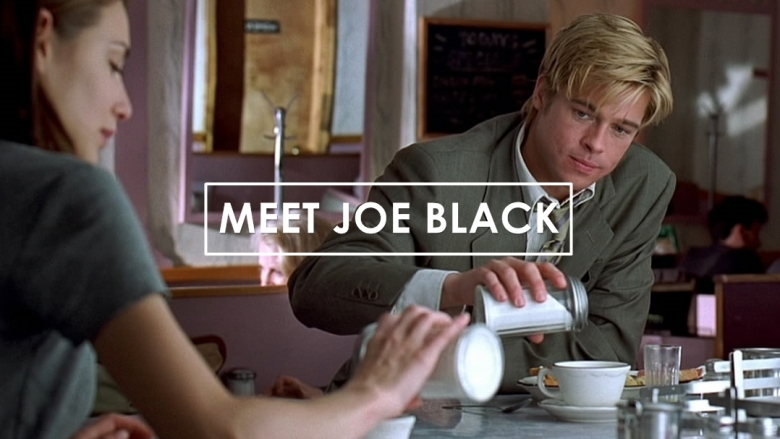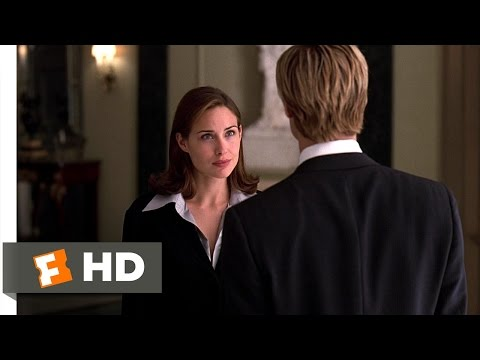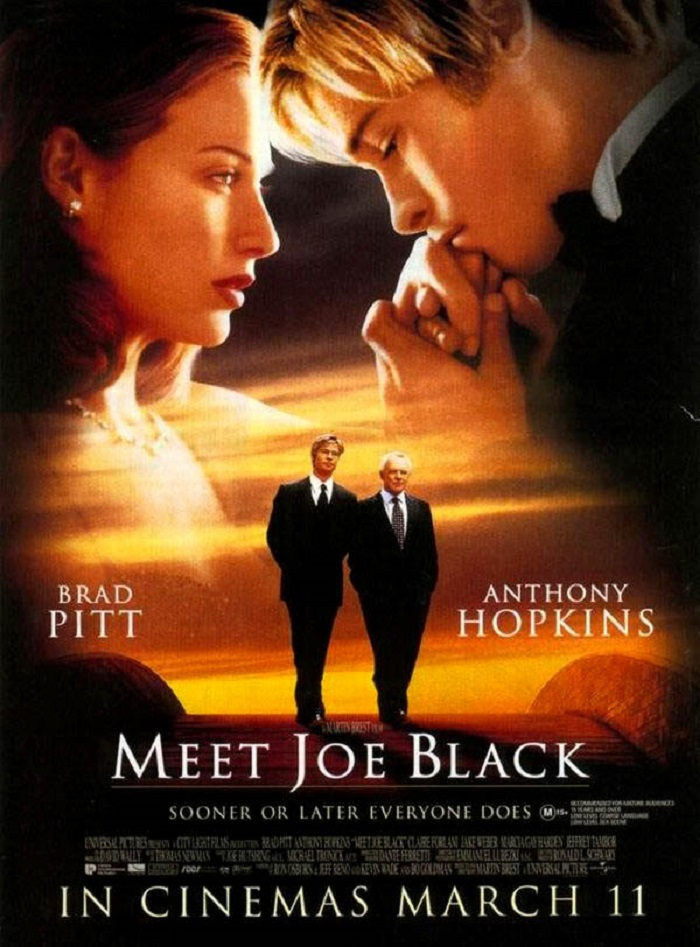Meet Joe Black

Introducing Meet Joe Black: A Cinematic Exploration of Life, Death, and Love
Meet Joe Black (1998) is a romantic fantasy drama directed by Martin Brest, known for films like Scent of a Woman and Beverly Hills Cop. This sprawling, contemplative film stars Brad Pitt, Anthony Hopkins, and Claire Forlani, weaving a unique narrative that blends supernatural elements with profound human emotions. Loosely based on the 1934 film Death Takes a Holiday, itself inspired by Alberto Casella’s play La Morte in Vacanza, Meet Joe Black explores timeless themes: mortality, love, family, and the fleeting nature of existence. With its lush cinematography, heartfelt performances, and philosophical undertones, the film remains a polarizing yet unforgettable entry in late 20th-century cinema.

Plot Summary
Meet Joe Black centers on William “Bill” Parrish (Anthony Hopkins), a wealthy media mogul approaching his 65th birthday. As he grapples with his legacy and mortality, Bill is visited by Death itself, who takes the form of a mysterious young man named Joe Black (Brad Pitt). Death, intrigued by human life, strikes a deal with Bill: in exchange for more time on Earth, Bill must act as Joe’s guide, introducing him to the joys and complexities of human existence.
Joe’s arrival coincides with Bill’s family dynamics unfolding. His daughter, Susan (Claire Forlani), a compassionate doctor, becomes enamored with Joe, unaware of his true identity. Their romance, tender yet complicated, forms the emotional core of the film. Meanwhile, Bill faces corporate challenges as his company is targeted for a merger, and he must navigate betrayal within his inner circle, including from his ambitious protégé, Drew (Jake Weber).
As Joe experiences human pleasures—famously savoring peanut butter—and grapples with emotions like love, Bill confronts his impending death. The film builds toward a poignant climax, forcing characters to reconcile with life’s impermanence and the power of love.

Themes and Symbolism
At its heart, Meet Joe Black is a meditation on life’s fragility and the inevitability of death. The film personifies Death as Joe, a curious and almost childlike figure, to explore what it means to be human. Through Joe’s journey, the movie examines the beauty of fleeting moments—whether it’s tasting food, falling in love, or cherishing family. The peanut butter scene, where Joe delights in a simple human pleasure, has become iconic for symbolizing the joy in life’s small details.
Love, both romantic and familial, is another central theme. The romance between Joe and Susan is tender and earnest, though some critics argue it lacks depth due to the film’s pacing. Bill’s relationships with his daughters, Susan and Allison (Marcia Gay Harden), highlight unconditional love and sacrifice, as he seeks to protect them while facing his mortality.
The film also critiques materialism and ambition. Bill’s corporate empire and the scheming of characters like Drew contrast with the purity of Joe’s curiosity and Susan’s sincerity, underscoring the emptiness of power without purpose.

Cast and Performances
The performances in Meet Joe Black are a standout, with Anthony Hopkins delivering a masterful portrayal of Bill Parrish. His gravitas and vulnerability anchor the film, conveying a man wrestling with legacy and loss. Brad Pitt, fresh off roles in Seven and 12 Monkeys, brings an otherworldly charm to Joe Black. His stiff, deliberate movements and wide-eyed wonder effectively convey Death’s unfamiliarity with humanity, though some viewers find his performance uneven as the film shifts to romance. Claire Forlani’s Susan is luminous and heartfelt, though her character is somewhat underwritten, relying on her chemistry with Pitt to carry their scenes.
Supporting performances add depth: Marcia Gay Harden shines as Allison, Bill’s devoted daughter, and Jake Weber is suitably slimy as Drew. Jeffrey Tambor, as Allison’s quirky husband Quince, provides subtle comic relief, balancing the film’s heavier themes.

Direction and Cinematography
Martin Brest’s direction is ambitious, aiming for an epic, almost mythic tone. The film’s 181-minute runtime allows for sprawling character moments but has drawn criticism for its leisurely pace. Brest’s choice to linger on quiet scenes—such as Bill’s introspective moments or Joe’s fascination with the world—creates a contemplative atmosphere, though it tests some viewers’ patience.
Cinematographer Emmanuel Lubezki (The Tree of Life, Gravity) crafts a visually stunning film. The warm, golden hues of Bill’s opulent mansion contrast with cooler tones in scenes of corporate intrigue, reflecting the clash between personal and professional worlds. The film’s final sequence, set during Bill’s birthday party with fireworks illuminating the night, is a visual and emotional triumph, symbolizing closure and transcendence.

Music and Soundtrack
Thomas Newman’s score is a highlight, blending ethereal and emotional tones to underscore the film’s themes. The iconic track “Whisper of a Thrill” captures the delicate balance of love and loss, enhancing key scenes. The soundtrack also includes classics like “What a Wonderful World” by Louis Armstrong, reinforcing the film’s celebration of life’s beauty.
Reception and Legacy
Upon release, Meet Joe Black received mixed reviews. Critics praised its performances, visuals, and ambition but often criticized its runtime and pacing. Roger Ebert gave it three stars, calling it “lovely and ambitious” but noting its length could feel indulgent. The film grossed $143 million worldwide against a $90 million budget, a modest success but not a blockbuster.
Over time, Meet Joe Black has gained a cult following, particularly for its emotional depth and memorable moments like the peanut butter scene. Its exploration of mortality resonates more as audiences age, and its romantic elements appeal to those drawn to epic love stories. However, its length and slow burn remain divisive, with some calling it a flawed masterpiece and others an overlong curiosity.

Cultural Impact
Meet Joe Black has left a mark on pop culture, particularly through its iconic scenes and quotes. Lines like “Don’t blow smoke up my ass, it’ll ruin my autopsy” (delivered by Hopkins) and Joe’s peanut butter obsession are frequently referenced. The film’s blend of fantasy and drama has influenced later works exploring similar themes, such as The Curious Case of Benjamin Button (also starring Pitt).

Why Watch Meet Joe Black?
Meet Joe Black is not a film for everyone. Its deliberate pace and philosophical musings require patience, but for those willing to invest, it offers a rewarding experience. The film invites viewers to reflect on their own lives—what matters most, what they’d regret, and how they’d face the end. Its blend of romance, fantasy, and drama, anchored by stellar performances and a gorgeous aesthetic, makes it a unique entry in the careers of its stars and director.
For fans of thought-provoking cinema or those seeking a heartfelt story about life’s big questions, Meet Joe Black is worth the journey. Watch it for Hopkins’ commanding presence, Pitt’s enigmatic charm, and a reminder to savor life’s simple pleasures—like a spoonful of peanut butter.